Are you a Quiet Speculation member?
If not, now is a perfect time to join up! Our powerful tools, breaking-news analysis, and exclusive Discord channel will make sure you stay up to date and ahead of the curve.
After weeks of waiting, the time has come! Eldrazi is gone, and we could possibly be on the precipice of a Control Takeover. Before I wake from this dream, I have to do the only thing I know how: analyze! This week, we’ll briefly go over the ban announcement, the immediate impacts, and make some predictions as to how Modern will evolve to incorporate these changes.

With everyone in the community brewing up Sword of the Meek decklists, how can we get a step ahead of the competition? Rather than just cobbling together a 75 with outdated information, let’s instead put to paper what we can infer about how Modern will react to these changes. Hopefully, we’ll have a stronger understanding of not only how things will change, but why. Let’s get to it.
[wp_ad_camp_1]
Context
April 4, 2016 Banned and Restricted Announcement
Eye of Ugin is banned.
Ancestral Vision is unbanned.
Sword of the Meek is unbanned.
Eye of Ugin
Wizards' banning of Eye of Ugin over Eldrazi Temple is probably for the best, and for a few reasons. With Eye gone and Eldrazi Temple remaining, the archetype can remain relatively intact. At its core, the Eldrazi deck is 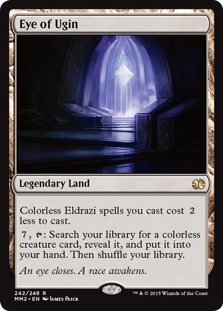 mostly fair when compared with the rest of Modern, even though the eight Sol lands pushed it over the top. Removing Eye of Ugin takes away the possibility of busted turns (free Eldrazi Mimics, 4+ mana out of one land on double-spell turns) and puts a strict leash on the deck. Eldrazi Temple is still powerful, but so is Mox Opal, Noble Hierarch, and the Tron lands. Eight copies of a pushed card is broken, while four copies is much more reasonable.
mostly fair when compared with the rest of Modern, even though the eight Sol lands pushed it over the top. Removing Eye of Ugin takes away the possibility of busted turns (free Eldrazi Mimics, 4+ mana out of one land on double-spell turns) and puts a strict leash on the deck. Eldrazi Temple is still powerful, but so is Mox Opal, Noble Hierarch, and the Tron lands. Eight copies of a pushed card is broken, while four copies is much more reasonable.
With Eye of Ugin gone, Eldrazi loses explosiveness, consistency, and late-game inevitability (as does Tron, which is worth mentioning). This last point is telling, as Wizards’ unbannings and explanation point strongly towards a desire for a true control presence in Modern. R/G Eldrazi tutoring for World Breaker, U/W finding Drowner of Hope, or even just drawing an extra card a turn (where that card is always gas) is a nightmare for control and midrange decks alike. While I was hoping for an Eldrazi Temple ban because I just wanted the archetype gone, a diminished Eldrazi is probably better for the format, not to mention Wizards’ pack sales.
Ancestral Vision
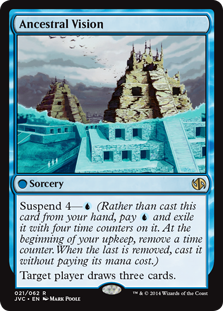 Of the blue control cards currently on the banlist (Jace, the Mind Sculptor, Ponder, Preordain, Treasure Cruise, Dig Through Time) Ancestral Vision has often been called the least deserving of the bunch. The main argument in favor of an unban has been this: in a Turn Four format, drawing three cards on turn five doesn’t seem that overpowered, right? Besides, this is assuming you had Ancestral Vision on turn one, and were either on the play or your opponent didn’t have discard! While the argument is slightly more complicated than that, there is some truth to their point. Compared to the now-banned Splinter Twin, or to Living End, turn three Karn Liberated, and similar strategies, drawing three cards seems downright benign.
Of the blue control cards currently on the banlist (Jace, the Mind Sculptor, Ponder, Preordain, Treasure Cruise, Dig Through Time) Ancestral Vision has often been called the least deserving of the bunch. The main argument in favor of an unban has been this: in a Turn Four format, drawing three cards on turn five doesn’t seem that overpowered, right? Besides, this is assuming you had Ancestral Vision on turn one, and were either on the play or your opponent didn’t have discard! While the argument is slightly more complicated than that, there is some truth to their point. Compared to the now-banned Splinter Twin, or to Living End, turn three Karn Liberated, and similar strategies, drawing three cards seems downright benign.
When paired with control strategies, Ancestral Vision transforms from a “slow” value-spell into a potent mid-game goal, and a relatively certain win condition in the form of inevitability. Control decks leveraging disruption and counterspells against their opponent can delay the game past their turn four goldfish draws, to the point where three extra cards becomes not merely influential but actually scale-tipping. Common gameflow has most players emptying their hands by turn four/five, as illustrated here:
- Turn 1: Land, spell
- Turn 2: Land, spell
- Turn 3: Land, spell
- Turn 4: Land, spell, spell
- Turn 5: Spell, spell, (maybe a 5th land)
With a starting hand of seven, plus four draws on the play, five on the draw, you can expect both players to be twelve cards deep by turn five. Thus, players should have at most one or two cards by the end of turn five assuming normal conditions and minimal wasted mana. Resolving an Ancestral Vision at this point of the game can be devastating, said Marshall Sutcliffe. Throw in the fact that the mana investment has already been paid, giving you “free” cards on an often pivotal turn, and you can start to see why Ancestral Vision was considered ban-worthy for the entirety of Modern.
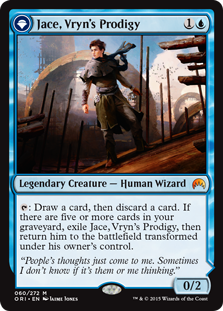 Ancestral Vision has some drawbacks, however. Waiting four turns for our draw three can be fatal if we’re up against the ropes, and Ancestral Vision is a poor topdeck if we’re behind on board or close to death. Ancestral Vision interacts poorly with Jace, Vryn's Progidy and Snapcaster Mage (two of the best reasons to play Blue in Modern). Also, it places heavy pressure on control players to cast it as soon as possible, leading to awkward turn two’s with counterspells and can put us behind on board against one-drop creatures if we’re casting Visions over removal.
Ancestral Vision has some drawbacks, however. Waiting four turns for our draw three can be fatal if we’re up against the ropes, and Ancestral Vision is a poor topdeck if we’re behind on board or close to death. Ancestral Vision interacts poorly with Jace, Vryn's Progidy and Snapcaster Mage (two of the best reasons to play Blue in Modern). Also, it places heavy pressure on control players to cast it as soon as possible, leading to awkward turn two’s with counterspells and can put us behind on board against one-drop creatures if we’re casting Visions over removal.
Of course, the most exciting potential of Ancestral Vision is its immediate response to an over-saturated aggressive metagame. Ancestral Vision plays perfectly into a control deck's Plan A; disrupt, interact, stabilize, turn the corner. Where pure control decks previously had to hope cards like Sphinx's Revelation and Celestial Colonnade were good enough, now they can just play normal Magic, resolve Ancestral Vision and calmly take control from there. Diverse control hate is present in Modern, and has been used before to great success, but the greatest enemy for the control archetype has always been a field too diverse to truly take control by playing reactively. Ancestral Vision, on surface level, seems like it could change this.
Sword of the Meek
Useless by itself, but when paired with Thopter Foundry the Sword of the Meek combo can provide a potent stream of 1/1s and life points limited only by the amount of mana we have to spend and our opponent’s patience. With help,  Foundry/Sword on a stable board can singlehandedly shut the door against all aggro decks, and given enough time can even generate enough material advantage to beat any combat-oriented opponent on its own. Foundry's/Sword’s true strength comes in its ease of use; sure, both cards are poor on their own, but assembling them together often slams the door on anyone fighting fair. In old Extended, many decks (even dedicated Combo strategies) found five-seven slots for Foundry/Sword, because mise.
Foundry/Sword on a stable board can singlehandedly shut the door against all aggro decks, and given enough time can even generate enough material advantage to beat any combat-oriented opponent on its own. Foundry's/Sword’s true strength comes in its ease of use; sure, both cards are poor on their own, but assembling them together often slams the door on anyone fighting fair. In old Extended, many decks (even dedicated Combo strategies) found five-seven slots for Foundry/Sword, because mise.
With Sword’s unbanning, control has a proven late-game option should they want it, and we could possibly see various midrange decks adopting the strategy as well. Tezzeret decks of various flavors have incorporated the combo in the past, looking to take advantage of Tezzeret, the Seeker and his tutor ability to find both halves of the combo. Modern has checks in place in the form of prevalent artifact hate for Affinity, and it will interesting to see if Foundry/Sword can carve out a niche (pun definitely intended).
Similar to Ancestral Vision, we can't overstate the presumed impact of Sword of the Meek on an over-saturated aggressive metagame. Against aggressive archetypes, assembling Sword/Foundry is usually game over, as Sword of the Meek can immediately stabilize the board and push the user out of burn range, and can even win the game by itself going late. Sword of the Meek stabilizes, invalidates opposing draws, and wins the game, all in one card. Once it hits the field, activating Sword as much as possible is often just the best possible thing to do, similar to Pack Rat in old Return to Ravnica Standard. Linear archetypes like Zoo, Affinity, Burn, and even Infect (short of unblockable Blighted Agent) will all have to adjust to Sword's presence, should it prove to be a force in Modern.
Predictions
Moving forward, my predictions for how Modern will adapt to these banlist changes hinges on a few standpoints. In particular order:
- Eldrazi as an archetype will remain; diminished but present nonetheless.
- Ancestral Vision will sponsor a control resurgence of some undefined measure.
- Foundry/Sword will find its way into the metagame in some fashion, be it a new archetype or existing strategy.
Those seem like safe predictions, but that’s the idea. When looking ahead, its best to establish a Level 0; a list of things we can assume with some certainty. This not only keeps us grounded, but also lets us concentrate on the possibilities as a whole rather than blinding us into a narrow focus. For example, were we to focus single-mindedly on the possibility of Foundry/Sword as a dedicated strategy, we could go through testing, find that it doesn’t stand up to hate, and move on with the assumption that it won’t influence the metagame. If we start from a broader perspective, we could imagine how Foundry/Sword could be incorporated into existing archetypes like U/W Control, Lantern, or maybe even Jund Midrange, and get a much clearer view of the possibilities.
In my "Context" portion I already wrote a bit on why I think the above three points are relatively safe bets, so this will serve as our baseline for speculation. From here, we embark on a journey; filled with guesswork, fraught with presumption, dogged by assumption. Enter at your own risk.
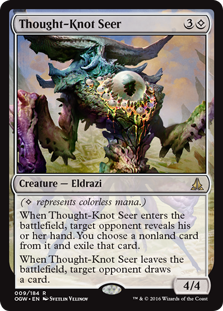 Eldrazi will morph from a format devastator to a reality check in Modern. A diminished, but still present, Eldrazi archetype will have a few effects. One, Burn will have a slightly easier time keeping up, but I believe will still fall short in the matchup. Eldrazi has tools available to fight Burn should they need it, and haven’t had to implement them up to this point. Chalice of the Void is still nuts, and an excellent tool against a bunch of decks in the format. Two, non-interactive decks like Tron and Scapeshift will still be pressured into interaction by the hard-hitting Eldrazi, reducing their overall potency against the field.
Eldrazi will morph from a format devastator to a reality check in Modern. A diminished, but still present, Eldrazi archetype will have a few effects. One, Burn will have a slightly easier time keeping up, but I believe will still fall short in the matchup. Eldrazi has tools available to fight Burn should they need it, and haven’t had to implement them up to this point. Chalice of the Void is still nuts, and an excellent tool against a bunch of decks in the format. Two, non-interactive decks like Tron and Scapeshift will still be pressured into interaction by the hard-hitting Eldrazi, reducing their overall potency against the field.
Abzan Company will gain dominance over Eldrazi, but will be hindered by control. Already blessed by a favorable Eldrazi matchup, Abzan Company was kept in second-place by the sheer unfairness of Eldrazi, which saw it still winning matches in an unfavorable matchup. Now that the playing field has been leveled, we can expect to see Abzan Company take a sizable portion of Eldrazi’s market share, and the onus will be on Eldrazi to make the next move in this matchup. On the other hand, Abzan Company is about to gain a new enemy, in the form of control decks. Whether control will be Grixis, U/W, or some other color combination is unclear, but removal/counterspells backed up by card advantage has proven tough for Abzan Company to overcome, and I imagine this will continue in the future.
 Control decks will fight an increasingly aggressive, linear field. With Ancestral Vision heavily incentivizing aggressive decks to finish off control before they gain much needed resources to stabilize, I expect we’ll see aggro become even more hyper-aggressive in response. Draw effects like Ancestral Vision have a tendency to push out the middle of the archetype spectrum, polarizing fields that once were diverse. We saw this before with Treasure Cruise, and while Ancestral Vision is no Treasure Cruise I expect we might see a similar, smaller effect here.
Control decks will fight an increasingly aggressive, linear field. With Ancestral Vision heavily incentivizing aggressive decks to finish off control before they gain much needed resources to stabilize, I expect we’ll see aggro become even more hyper-aggressive in response. Draw effects like Ancestral Vision have a tendency to push out the middle of the archetype spectrum, polarizing fields that once were diverse. We saw this before with Treasure Cruise, and while Ancestral Vision is no Treasure Cruise I expect we might see a similar, smaller effect here.
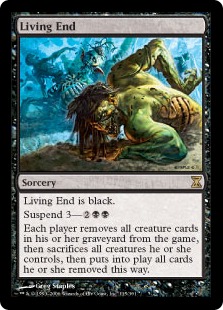 Focused combo strategies will fall away without discard help. With Ancestral Vision giving control archetypes a major boost in games going late, combo’s traditional plan against control (sculpt a solid hand for a pivotal turn) will face severe opposition. While Scapeshift and Storm can play Ancestral Vision of their own, other combo like Living End and Grishoalbrand will have some trouble. Besides just winning before Vision comes online, discard is the best way to combat Ancestral Vision, but even that might not be enough. You can expect any player with Ancestral Vision in their opener to play it on the first turn, meaning the opponent with discard has to not only have discard in their opener but also be on the play to snag Vision before its cast. A topdecked Vision in the early game is also impossible to defend against, though Vision does get rapidly worse as the game goes on.
Focused combo strategies will fall away without discard help. With Ancestral Vision giving control archetypes a major boost in games going late, combo’s traditional plan against control (sculpt a solid hand for a pivotal turn) will face severe opposition. While Scapeshift and Storm can play Ancestral Vision of their own, other combo like Living End and Grishoalbrand will have some trouble. Besides just winning before Vision comes online, discard is the best way to combat Ancestral Vision, but even that might not be enough. You can expect any player with Ancestral Vision in their opener to play it on the first turn, meaning the opponent with discard has to not only have discard in their opener but also be on the play to snag Vision before its cast. A topdecked Vision in the early game is also impossible to defend against, though Vision does get rapidly worse as the game goes on.
 Vision will sponsor an increase in discard and one-drops. We’ve covered discard above, as well as the increase in hyper-aggression, but the reason why might not be so clear. A control player casting Ancestral Vision on turn one means he/she is forgoing casting a Lightning Bolt or Thoughtseize instead. The Grixis Control/Burn matchup specifically is defined almost entirely on the first turn. Burn should almost always mulligan openers without a one-drop creature, as Grixis only has Lightning Bolt to kill it without losing tempo. Even if Grixis does have the Bolt, it’s often right to take two extra damage from Goblin Guide on Burn’s turn two to threaten Spell Snare on Eidolon of the Great Revel. None of this can happen if Ancestral Vision is being cast on turn one. (Note: This particular interaction is why Serum Visions (and now Ancestral Vision) will often be trimmed post-board against Burn). Expect almost all Burn lists to be of the Naya variety with Wild Nacatl, and other aggressive decks to ramp up their one-drop count as well.
Vision will sponsor an increase in discard and one-drops. We’ve covered discard above, as well as the increase in hyper-aggression, but the reason why might not be so clear. A control player casting Ancestral Vision on turn one means he/she is forgoing casting a Lightning Bolt or Thoughtseize instead. The Grixis Control/Burn matchup specifically is defined almost entirely on the first turn. Burn should almost always mulligan openers without a one-drop creature, as Grixis only has Lightning Bolt to kill it without losing tempo. Even if Grixis does have the Bolt, it’s often right to take two extra damage from Goblin Guide on Burn’s turn two to threaten Spell Snare on Eidolon of the Great Revel. None of this can happen if Ancestral Vision is being cast on turn one. (Note: This particular interaction is why Serum Visions (and now Ancestral Vision) will often be trimmed post-board against Burn). Expect almost all Burn lists to be of the Naya variety with Wild Nacatl, and other aggressive decks to ramp up their one-drop count as well.
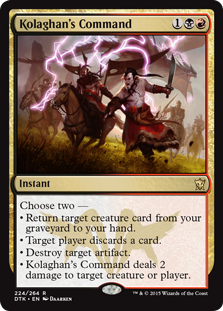 Dedicated Foundry/Sword decks will face maindeck hate. Before Eldrazi pushed everything else out of the metagame, Kolaghan's Command was seemingly everywhere, and we can expect a mini-Kolaghan's Command resurgence now that Eldrazi is gone. Affinity will go back to being at the forefront of everyone’s mind, and I expect Grixis Control to return as well, bolstered by Ancestral Vision. While Jund’s position in this new metagame is unclear, it’s safe to assume Kolaghan's Command will see maindeck play as artifacts will be rampant. Eldrazi is still playing Chalice of the Void, Affinity is still present, and now we have Thopter Foundry/Sword of the Meek added to the mix as well. Ancient Grudge, Stony Silence, and the like are here to stay as they always have been, and Foundry/Sword will have to take that into account when defining their role.
Dedicated Foundry/Sword decks will face maindeck hate. Before Eldrazi pushed everything else out of the metagame, Kolaghan's Command was seemingly everywhere, and we can expect a mini-Kolaghan's Command resurgence now that Eldrazi is gone. Affinity will go back to being at the forefront of everyone’s mind, and I expect Grixis Control to return as well, bolstered by Ancestral Vision. While Jund’s position in this new metagame is unclear, it’s safe to assume Kolaghan's Command will see maindeck play as artifacts will be rampant. Eldrazi is still playing Chalice of the Void, Affinity is still present, and now we have Thopter Foundry/Sword of the Meek added to the mix as well. Ancient Grudge, Stony Silence, and the like are here to stay as they always have been, and Foundry/Sword will have to take that into account when defining their role.
I expect Foundry/Sword to pop up first as a win condition in a U/W style Control deck rather than a dedicated Tezzeret archetype, but I also expect we’ll see attempts at both. Abrupt Decay, once widely accepted as the best answer in Modern, fell away from favor with the introduction of Tasigur, the Golden Fang and Gurmag Angler, and I predict Jund (and every BGx deck that can play it) to do so in the future. Reverberations from this decision impact Blood Moon, Ensnaring Bridge, and Pyromancer's Ascension specifically.
A lot of these points share many similarities with each other, to the point that they are not so much Venn Diagram as much as they are Spirograph, but I hesitate to combine some of them together. For example, point three and point five both deal with the immediate impact of Ancestral Vision to the established "baseline", but it is worth differentiating the two. An aggressive field as a result of Ancestral Vision could include a general increase in the amount of Tarmogoyf, for example, which isn't a one-drop. This is worth elaborating because should Ancestral Vision prove not powerful enough to see play in Modern Control decks (yet we still experience a control resurgence as a result of Sword of the Meek) we might see a more aggressive field without increased discard or one drops. Elaborating in this way might seem verbose, but can definitely be useful when trying to predict trends.
Conclusion
As we head into a fresh Spring, we’ll be leaving the cold dark memory of Eldrazi Winter behind us. Diminished, but not gone, Eldrazi remains, and along with Ancestral Vision and Sword of the Meek promise to influence the format. Will Control rise to the top? Will Affinity retake the throne? Will Sword of the Meek be as dominating a combo force as Splinter Twin? What do you think? Let me know in the comments and I’ll see you next week, with decklists!
Trevor Holmes
The_Architect on MTGO
twitch.tv/Architect_Gaming
twitter.com/7he4rchitect




Here’s to hoping AV is just the tool faeries is missing to bump it to a reasonable tier 2 stratagy!
Faeries does benefit from Vision’s printing, but it seems like Thopter Foundry/Sword of the Meek is going to give it a lot of trouble. What good answers does U/B have for that archetype, besides counterspells? I’m not sure we want Hurkyl’s Recall against a control deck, that plays right in to their “virtual card advantage” they generate by forcing us to draw narrow answers that rot in our hand instead of threats. Something to think about
The answer is Leyline of the Void, Trevor. So far, my UB Faeries list is 56% against various Thopter decks (UW, Grixis and Jeskai).
Torpor Orb (stops Sword from triggering, also very good against Persist combo), Leyline of the Void, Relic, Pithing Needle (on Foundry of course), Surgical Extraction (can respond to Sword trigger). Plus of course you just drop discard and rip Foundry before they can play it.
Just finished Grixis prior to the unbans. I’m unwilling to sink another $200 into it for Vision, plus it doesn’t interact well with 4x Snapcaster and 4x Jace. How do you think Infect is positioned?
My brother has had a similiar problem with his blue moon. He actually managed to save money. He cut snapcasters down to 2 ofs and cut a blood moon because AV would help him draw into them. Then, he replaced his keranos with goblin dark dwellers. You could cut a snap and two jace and maybe a thought scour or tasigur and add in 2 dark dwellers and 3 AV and be at a cheaper cost
I imagine Blighted Agent becomes their primary plan against Foundry/Sword, then again that combo really can’t come online until Turn 4 and if the Sword player is tapping out to play combo pieces they will be dead quickly. That matchup probably comes down to how well the Sword deck is built to combat Infect in the early turns.
As for the rest of the metagame, a control presence will make things difficult for Infect as well, but Infect does have anti-control tools if they can find the room. From a purely speculative level I’m not sure it will be “great”, but only a few things have to happen for that outlook to change drastically.
Loving the idea of Goblin Dark-Dwellers in Grixis Control. That alone is going to fuel a resurgence in the archetype. I’m also confident that Sword + Thopter will find a niche – the combo is too good against fair decks to not see any play. I don’t think it will be super widespread, though – it’s great in Lantern Control and I think it will make the deck a fixture in the tier listings, but I’m skeptical on whether it can be plugged into UWx Control and be expected to work (maybe Ancestral Vision will make it easier to dig for?). I also think Colorless (or perhaps Black-and-Colorless) Eldrazi will survive – as you said, Chalice is great, and Temple + Simian Spirit Guide is probably enough ramp juice to power out some quick Eldrazi. All in all, I’m excited to see what the meta brings.
I have been running games on untap.in (a mtg sim program) Thus far, sword combo is very good. The concensus seems to be that it might be too good, as it has been shoved into grixis, uwr, uw, 4 color and tezzerator with good success. It is powerful not only because it is hard to interact with, but because they must bring in cards to counter it, making them more vulnerable to normal win conditions.
Visions has seen play in all the above lists and also showed up in a crazy UG taking turns deck that basically wins on t3/4
Too hard to interact with? Are we still talking about a combo that relies on the graveyard, artifacts, tokens, and 11 creatures? Because that would be an awful lot of ways to interact wouldn’t it? You know with cards people already play anyways? Stony silence, rip, nosb, grudge, surgical, staticaster, etc. Etc
The main strength of Foundry/Sword is it’s ability to slot into almost any deck, and force the opponent to bring in narrow answers to deal with it, besides counterspells. A good second plan of attack for control/midrange, I’m more excited to see what it does in those decks rather than dedicated Foundry/Sword lists.
I don’t know if I consider the answers to Thopter/Sword to be that narrow. If we’re talking about ultra-specific answers like Ancient Grudge, Night of Soul’s Betrayal, or Stony Silence, then sure – but we’re playing those cards in our sideboards for other match-ups already so it’s not like the combo is asking us to play cards specifically for that match-up.
Scavenging Ooze, Relic, Abrupt Decay, Pithing Needle, Izzet Staticaster, Quasili Pridemage, Kolaghan’s Command and more are all capable of answering a resolved combo (with varying degrees of success, mind you) and many of them can even be played proactively. In addition, all of these cards can answer multiple aspects of potential Thopter/Sword lists beyond just the combo itself.
An article without grixis deck lists?! Trevor are you ill?
On a more serious note I’m looking forward to your next article.
I could write 10,000 words about the nuances of Grixis (and I probably already have by now) so I figured it best to give Grixis a whole article. Stay tuned!
Did that Naya Blitz Human list with Thalia’s Lieutenant can duke it out on this format, or Thopter/Sword is just too punishing?